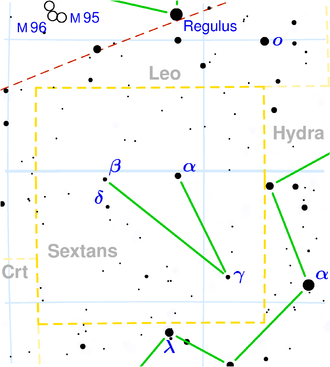NGC 2969
| Galaxie NGC 2969 | |
|---|---|
 | |
| AladinLite | |
| Sternbild | Sextant |
| Position Äquinoktium: J2000.0, Epoche: J2000.0 | |
| Rektaszension | 09h 41m 54,5s[1] |
| Deklination | -08° 36′ 11″[1] |
| Erscheinungsbild | |
| Morphologischer Typ | SA(s)c pec: / HII[1] |
| Helligkeit (visuell) | 13,1 mag[2] |
| Helligkeit (B-Band) | 13,8 mag[2] |
| Winkelausdehnung | 1,4′ × 1,2′[2] |
| Positionswinkel | 145°[2] |
| Flächenhelligkeit | 13,5 mag/arcmin²[2] |
| Physikalische Daten | |
| Rotverschiebung | 0.016545 ± 0.000030[1] |
| Radialgeschwindigkeit | (4960 ± 9) km/s[1] |
| Hubbledistanz vrad / H0 | (214 ± 15) · 106 Lj (65,5 ± 4,6) Mpc [1] |
| Geschichte | |
| Entdeckung | William Herschel |
| Entdeckungsdatum | 27. März 1786 |
| Katalogbezeichnungen | |
| NGC 2969 • PGC 27714 • MCG -01-25-021 • 2MASX J09415451-0836110 • Mrk 1235 • GC 1900 • H III 527 • h 628 • | |
NGC 2969 ist eine Spiralgalaxie vom Hubble-Typ Sc im Sternbild Sextant. Sie ist schätzungsweise 214 Millionen Lichtjahre von der Milchstraße entfernt.
Das Objekt wurde am 27. März 1786 von Wilhelm Herschel entdeckt.[3]
Weblinks
Einzelnachweise
Auf dieser Seite verwendete Medien
Autor/Urheber: Donald Pelletier, Lizenz: CC BY-SA 4.0
Image created using the Aladin Sky Atlas software from the Strasbourg Astronomical Data Center and
Pan-STARRS ([https://panstarrs.stsci.edu/ Panoramic Survey Telescope And Rapid Response System)
public data.


